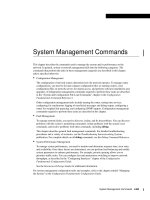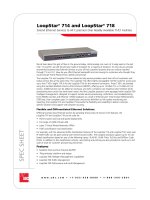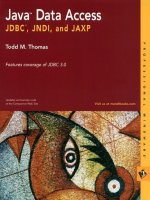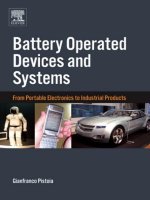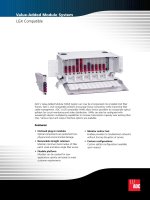Tài liệu LoopStar® SONET Access System Cell Site Backhaul Aggregation and Transport pdf
Bạn đang xem bản rút gọn của tài liệu. Xem và tải ngay bản đầy đủ của tài liệu tại đây (221.31 KB, 4 trang )
APPLICATION NOTE
www.adc.com • +1-952-938-8080 • 1-800-366-3891
LoopStar
®
SONET Access System
Cell Site Backhaul Aggregation and Transport
Overview
One of the greatest challenges facing mobile operators today is reducing the cost of the
backhaul portion of their network, while increasing reliability and revenue generating
opportunities. Additionally, mobile operators need to be sure that the backhaul transport
solution is capable of addressing the traditional 1 and 2G-based Radio Access Networks
(RANs) as well as the 3G-based RANs. The number of 3G-based RANs will grow driven by
new services with higher bandwidth that enable end-users to get broadband access through
their mobile devices.
Traditionally, the backhaul portion of the mobile wireless network has consisted largely of
multiple, leased T1 lines or privately owned microwave connections that backhaul traffic from
base-station transceiver subsystems (BTS) to mobile switching centers (MSCs). These solutions
are expensive and not easily scalable. Therefore, with SONET and DS3 connections becoming
more affordable, mobile operators have begun implementing, either on their own or through
a local exchange carrier (LEC), a complete backhaul solution, including traffic grooming and
multiplexing. Previously, much of the traffic grooming and multiplexing has been handled
at a DS0 to DS1 level. For cellular voice traffic this has been acceptable; however, as 3G
rollouts begin, the bandwidth required by new applications will require traffic grooming and
multiplexing at DS1 rates and above, as well as IP/Ethernet connectivity. Wireless carriers
estimate that the roll out of data services will require increasing backhaul capacity 25 percent.
With the existing and new traffic requirements at a given cell site, multiple point-to-point
T1 connections would be required for transporting existing services, and a Gigabit Ethernet
(or optical 100BaseT) or DS-3 connection would be required to transport data from each
2.5G/3G site. Consolidating this traffic onto a common optical transport backbone, can save
a mobile operator as much as 50 percent in backhaul transport costs. By owning the network
and aggregating the traffic, the mobile operator hands off a single connection to the MSC
and a single connection to the Internet instead of multiple, costly, point-to-point connections.
For mobile operators, ADC’s LoopStar SONET solution provides the perfect combination of
service flexibility, network reliability, and cost-savings to address both current and future cell
site backhaul needs.
9/06 • 103322AE
LoopStar SONET Acess System
LoopStar
®
SONET Acess System
Cell Site Backhaul Aggregation and Transportation
2
www.adc.com • +1-952-938-8080 • 1-800-366-3891
Service Flexibility
The introduction of 3G data services will create a significant increase in bandwidth requirements.
Mobile operators need to be able to migrate to these new services while continuing to serve their
existing customers. In order to efficiently add transport services, a LoopStar 800 is needed that can
aggregate traffic from existing DS0 DACS and provide Ethernet connectivity for new, data-based
services. With the LoopStar 800’s grooming capabilities, carriers and/or operators can efficiently scale
the bandwidth added at each site in increments as low as 1.5 Mbps. Likewise, data services can be
offered using the LoopStar 800’s 10/100/1000BaseT Ethernet card.
Network Reliability
Mobile operators currently receive between $500,000 and $1,000,000 in annual revenue from a
single cell site, and reliability is a top priority. The LoopStar 800’s SONET interfaces provide 1+1 LAPS
or UPSR protection. In addition, tributary protection is provided for TDM interfaces. For a DS1 card, it
is 1:n (n=1, 2, or 3) and for a DS3 card, it is 1:n (n=1 or 2). Although the LoopStar 800 provides no
Ethernet protection, operators can deploy two cards and run spanning tree transparently across the
SONET network. With its protection flexibility, the LoopStar 800 provides one of the most reliable and
versatile products available for use in cell site backhaul applications.
Aggregation
Mobile operators require aggregation throughout their networks to minimize connection costs and
simplify management of the network. Typically, there are T1s coming from multiple cell sites and
multiple T3s coming from microwave sites. The density of connections can be quite high at these
sites. Also, traffic grooming at the T1 level is critical because the T3s from the microwave sites are
frequently channelized with the T1s inside not always going to the same destination(s). Therefore,
equipment at these sites must be capable of providing a significant number of T1 and T3 connections
and still be able to groom the traffic effectively.
Radio
Cell Site
Cell Site
Tower
Ethernet
TDM
Network
DS1
DS3
SONET
OC-3/12
Data
Network
Moble Switching
Telephone Office
SONET
OC-3/12
Radio
L
o
opStar 800
Cell Site
Cell Site
Tower
Analog/Digital
3G
GPS/EDGE
LoopStar 800
SONET
OC-3/12
DS1s
4
LoopSta
r
800
9/06 • 103322AE
LoopStar SONET Acess System
LoopStar
®
SONET Acess System
Cell Site Backhaul Aggregation and Transportation
3
www.adc.com • +1-952-938-8080 • 1-800-366-3891
The LoopStar 800 and 1600 provide the capability to effectively mux and groom traffic at key
aggregation points within the mobile operator’s network. Both platforms can be equipped with DS1
cards and DS3 transmux cards, which enable mobile operators to re-groom the payload of the T3s
coming from the microwave sites. The LoopStar 1600 satisfies applications requiring 84 or more DS1s
and up to 48 DS3s. The LoopStar 800 is a more cost-effective means of providing up to 84 DS1s, 24
DS3s, or various combinations of both.
Cost-Savings
Traditionally, mobile operators spend roughly 20-30% of their engineering budget on backhaul. U.S.
wireless carriers will spend over $2 billion on backhaul in 2006. Since SONET and DS3 connections
have become cheaper, there are now definite cost-savings associated with aggregating traffic at BTS
sites for transport back to the MSC. The LoopStar 800’s ability to efficiently aggregate T1s as well
as data traffic can significantly reduce the mobile operators network expense. Instead of multitudes
of costly T1 connections, the LoopStar 800 aggregates T1s and Ethernet traffic across the SONET
network and hands them off at the Central Office as a single DS3 (using the Transmux card) to the
MSC or as a 10/100/1000BaseT Ethernet connection to the Internet .
Due to the varying amounts and types of equipment that may exist at a cell site, remote management
may be required necessitating an extra T1 or a LAN connection. In addition to achieving real cost-
savings by aggregating the customer’s TDM and data traffic across the SONET infrastructure, remote
management connectivity for existing equipment can also be transported cost effectively via the
LoopStar SONET payload. The management traffic is securely mapped into one or more DS1s or
VLANs for transport to the Network Operations Center (NOC). Additionally, the LoopStar 800 can
monitor up to eight housekeeping alarms at a cell site. The LoopStar 800 reports these alarms over
the Data Communications Channel (DCC) to the NOC, further reducing costs by eliminating the need
to send a technician to the site.
Summary
In summary, the LoopStar SONET solution enables mobile operators to drastically reduce their
costs and operational concerns surrounding cell site backhaul. The LoopStar 800 accomplishes this
through efficient aggregation and transport of legacy TDM services and 2.5/3G data services, which
eliminates the need for dedicated, point-to-point connections to each cell site. Finally, the LoopStar
800’s cost effectiveness and ease of management make it ideal for mobile operators who are
considering owning the SONET backhaul network and for carriers who provide backhaul services to
mobile operators.
APPLICATION NOTE
Web Site: www.adc.com
From North America, Call Toll Free: 1-800-366-3891 • Outside of North America: +1-952-938-8080
Fax: +1-952-917-3237 • For a listing of ADC’s global sales office locations, please refer to our web site.
ADC Telecommunications, Inc., P.O. Box 1101, Minneapolis, Minnesota USA 55440-1101
Specifications published here are current as of the date of publication of this document. Because we are continuously
improving our products, ADC reserves the right to change specifications without prior notice. At any time, you may
verify product specifications by contacting our headquarters office in Minneapolis. ADC Telecommunications, Inc.
views its patent portfolio as an important corporate asset and vigorously enforces its patents. Products orfeatures
contained herein may be covered by one or more U.S. or foreign patents. An Equal Opportunity Employer
103322AE 9/06 Revision © 2005, 2006 ADC Telecommunications, Inc. All Rights Reserved
